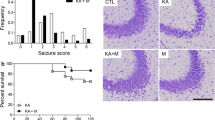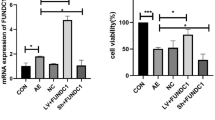Abstract
Omi/HtrA2 is a pro-apoptotic mitochondrial serine protease involved in caspase-dependent as well as caspase-independent cell death upon various brain injuries. However, the role of Omi/HtrA2 in neuronal death induced by status epilepticus (SE) in the immature brain has not been reported. In this study, we analyzed the contribution of serine protease Omi/HtrA2, its substrate X-linked inhibitor of apoptosis protein (XIAP) and the caspase-3 activation to damage of hippocamplal CA1 cells following lithium-pilocarpine SE in P14 rat pups. Status epilepticus in the immature brain significantly induced translocation of Omi/HtrA2 from mitochondria into the cytosol, increased cytosolic accumulation of Omi/HtrA2, induced appearance of XIAP-breakdown products and enhanced caspase-3 activity in the selectively vulnerable hippocampal CA1-subfield. Taken together, these results demonstrate for the first time that SE in the immature brain results in Omi/HtrA2 accumulation in the cytosol, where it probably promotes neuronal death by neutralizing and cleaving XIAP, one of the most potent endogenous inhibitors of apoptosis.




Similar content being viewed by others
References
Deveraux QL, Welsh K, Reed JC (2000) Purification and use of recombinant inhibitor of apoptosis proteins as caspase inhibitors. Meth Enzymol 322:154–156
Vaux DL, Silke J (2003) Mammalian mitochondrial IAP binding proteins. Biochem Biophys Res Commun 304:499–504
Verhagen AM, Silke J, Ekert PG, Pakusch M, Kaufmann H, Connolly LM, Day CL, Tikoo A, Burke R, Wrobel C, Moritz RL, Simpson RJ, Vaux DL (2002) Omi/HtrA2 promotes cell death through its serine protease activity and its ability to antagonize inhibitor of apoptosis proteins. J Biol Chem 277:445–454
Siegelin MD, Kossatz LS, Winckler J, Rami A (2005) Regulation of XIAP and Smac/DIABLO in the rat hippocampus following transient forebrain ischemia. Neurochem Int 46:41–51
Siegelin M, Touzani O, Toutain J, Liston P, Rami A (2005) Induction and redistribution of the XAF1, antagonist of XIAP in the rat brain after transient focal ischemia. Neurobiol Dis 20:509–518
Rami A, Bechmann I, Stehle J (2008) Exploiting endogenous anti-apoptotic proteins for novel therapeutic strategies in cerebral ischemia. Prog Neurobiol 85:273–296
Saito A, Hayashi T, Okuno S, Nishi T, Chan PH (2004) Oxidative stress is associated with XIAP and Smac/DIABLO signaling pathways in mouse brains after transient focal cerebral ischemia. Stroke 35:1443–1448
Yang QH, Church-Hajduk R, Ren J, Newton ML, Du C (2003) Omi/HtrA2 catalytic cleavage of inhibitor of apoptosis (IAP) irreversibly inactivates IAPs and facilitates caspase activity in apoptosis. Genes Dev 17:1487–1496
Blink E, Maianski NA, Alnemri ES, Zervos AS, Roos D, Kuijpers TW (2003) Intramitochondrial serine protease activity of Omi/HtrA2 is required for caspase-independent cell death of human neutrophils. Cell Death Differ 11:937–949
Wolf BB, Green DR (2003) Apoptosis: letting slip the dogs of war. Curr Biol 12:177–179
Martins LM, Iaccarino I, Tenev T, Gschmeissner S, Totty NF, Lemoine NR, Savopoulos J, Gray CW, Creasy CL, Dingwall C, Downward J (2002) The serine protease Omi/HtrA2 regulates apoptosis by binding XIAP through a reaper-like motif. J Biol Chem 277:439–444
Althaus J, Siegelin MD, Dehghani F, Cilenti L, Zervos AS, Rami A (2007) The serine protease Omi/HtrA2 is involved in XIAP cleavage and in neuronal cell death following focal cerebral ischemia/reperfusion. Neurochem Int 50:172–180
Sankar DH, Shin H, Liu A, Mazarati A, de Vasconcelos Pereira, Wasterlain CG (1998) Patterns of status epilepticus-induced neuronal injury during development and long-term consequences. J Neurosci 18:8382–8393
Racine RJ (1972) Modification of seizure activity by electrical stimulation II. Motor seizure. Electroencephalogr Clin Neurophysiol 32:281–294
Tan Z, Sankar R, Shin D, Sun N, Liu H, Wasterlain CG, Schreiber SS (2002) Differential induction of p53 in immature and adult rat brain following lithium-pilocarpine status epilepticus. Brain Res 928:187–193
Niquet J, Baldwin RA, Allen SG, Fujikawa DG, Wasterlain CG (2003) Hypoxic neuronal necrosis: protein synthesis-independent activation of a cell death program. Proc Natl Acad Sci USA 100:2825–2830
Niquet J, SeoDW AllenSG, Wasterlain CG (2006) Hypoxia in presence of blockers of excitotoxicity induces a caspase-dependent neuronal necrosis. Neuroscience 141:77–86
Lopez-Meraz ML, Wasterlain CG, Rocha L, Allen S, Niquet J (2010) Vulnerability of postnatal hippocampal neurons to seizures varies regionally with their maturational stage. Neurobiol Dis 37:394–402
Niquet J, Auvin S, Archie M, Seo DW, Allen S, Sankar R, Wasterlain CW (2007) Status epilepticus triggers caspase-3 activation and necrosis in the immature rat brain. Epilepsia 48:1203–1206
Holcik M, Gibson H, Korneluk RG (2001) XIAP: apoptotic brake and promising therapeutic. Apoptosis 6:253–261
Suzuki Y, Imai Y, Nakayama H, Takahashi K, Takio K, Takahashi R (2001) A serine protease, Omi/HtrA2, is released from the mitochondria and interacts with XIAP, inducing cell death. Mol Cell 8:613–621
Hegde R, Srinivasula SM, Zhang Z, Wassell R, Mukattash R, Cilenti L, DuBois G, Lazebnik Y, Zervos AS, Fernandes-Alnemri T, Alnemri ES (2002) Identification of Omi/HtrA2 as a mitochondrial apoptotic serine protease that disrupts inhibitor of apoptosis protein-caspase interaction. J Biol Chem 277:432–438
Okada H, Suh WK, Jin J, Woo M, Du C, Elia A, Duncan GS, Wakeham A, Itie A, Lowe SW, Wang X, Mak TW (2002) Generation and characterization of Smac/DIABLO-deficient mice. Mol Cell Biol 22:3509–3517
Cilenti L, Lee Y, Hess S, Srinivasula S, Park KM, Junqueira D, Davis H, Bonventre JV, Alnemri ES, Zervos AS (2003) Characterization of a novel and specific inhibitor for the pro-apoptotic protease Omi/HtrA2. J Biol Chem 278:11489–11494
Faccio L, Fusco C, Chen A, Martinotti S, Bonventre JV, Zervos AS (2000) Characterization of a novel human serine protease that has extensive homology to bacterial heat shock endoprotease HtrA and is regulated by kidney ischemia. J Biol Chem 275:2581–2588
Jones JM, Datta P, Srinivasula SM, Ji W, Gupta S, Zhang Z, Davies E, Hajnoczky G, Saunders TL, Van Keuren ML, Fernandes-Alnemri T, Meisler MH, Alnemri ES (2003) Loss of Omi mitochondrial protease activity causes the neuromuscular disorder of mnd2 mutant mice. Nature 425:721–727
Gillardon F, Böttiger B, Schmitz B, Zimmermann M, Hossmann KA (1997) Activation of CPP-32 protease in hippocampal neurons following ischemia and epilepsy. Mol Brain Res 50:16–22
Troy CM, Friedman JE, Friedman WJ (2002) Mechanisms of p75-mediated death of hippocampal neurons. Role of caspases. J Biol Chem 277:34295–34302
Weise J, Engelhorn T, Dorfler A, Aker S, Bahr M, Hufnagel A (2005) Expressiontime course and spatial distribution of activated caspase-3 after experimental status epilepticus: contribution of delayed neuronalcell death to seizure-induced neuronal injury. Neurobiol Dis 18:582–590
Ananth C, Thameem Dheen S, Gopalakrishnakone P, Kaur C (2001) Domoic acid-induced neuronal damage in the rat hippocampus: changes in apoptosis related genes (bcl-2, bax, caspase-3) and microglial response. J Neurosci Res 66:177–190
Fujikawa DG, Ke X, Trinidad RB, Shinmei SS, Wu A (2002) Caspase-3 is not activated in seizure-induced neuronal necrosis with internucleosomal DNA cleavage. J Neurochem 83:229–240
Acknowledgments
We are grateful to Angelika Langhagen for technical assistance. This work was funded in part by research grant from the Adolf-Messer-Stiftung (Grant to Dr. A. Rami).
Author information
Authors and Affiliations
Corresponding author
Additional information
This article is for the Special Issue in honor of Dr. Abel Lajtha.
Rights and permissions
About this article
Cite this article
Rami, A., Kim, M. & Niquet, J. Translocation of the Serine Protease Omi/HtrA2 from Mitochondria into the Cytosol Upon Seizure-Induced Hippocampal Injury in the Neonatal Rat Brain. Neurochem Res 35, 2199–2207 (2010). https://doi.org/10.1007/s11064-010-0322-0
Accepted:
Published:
Issue Date:
DOI: https://doi.org/10.1007/s11064-010-0322-0




